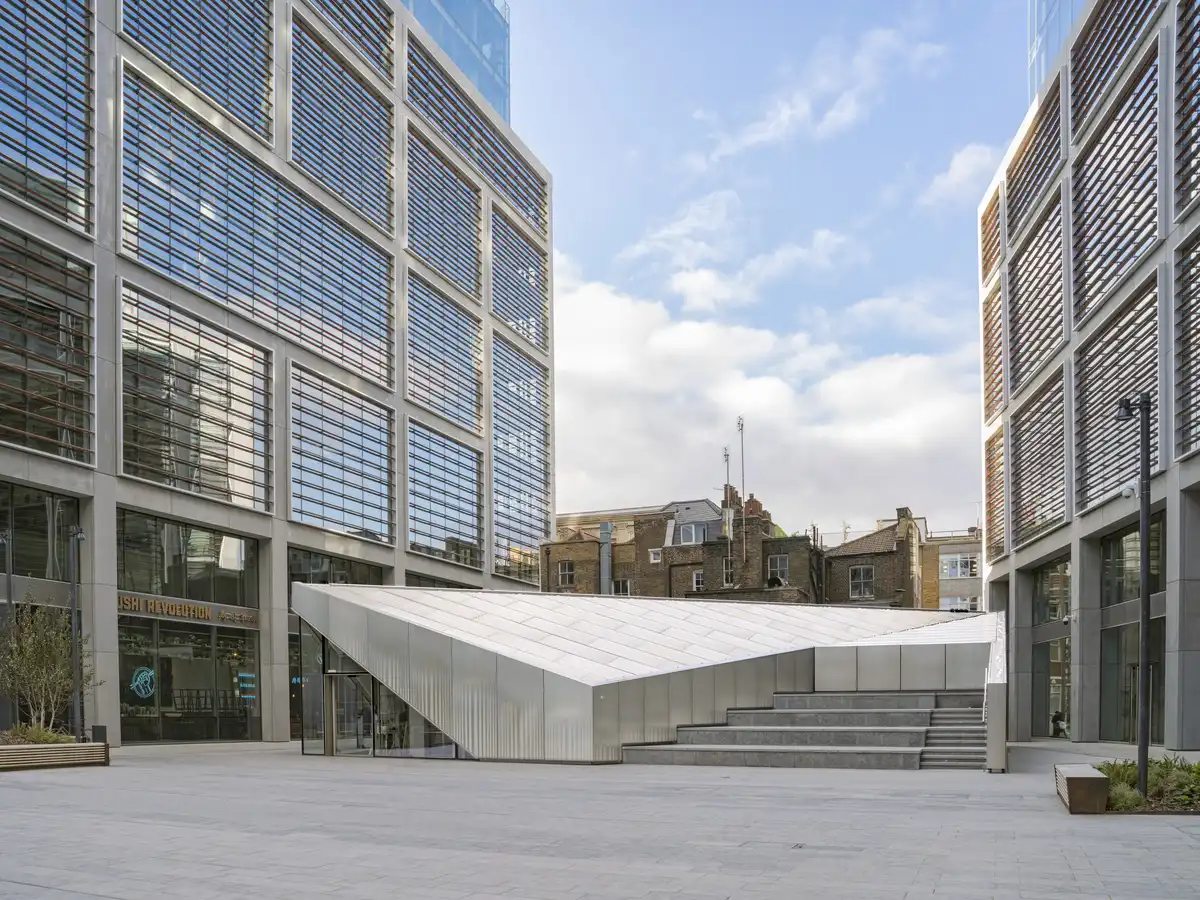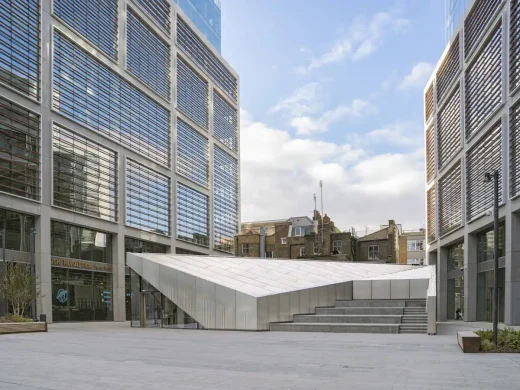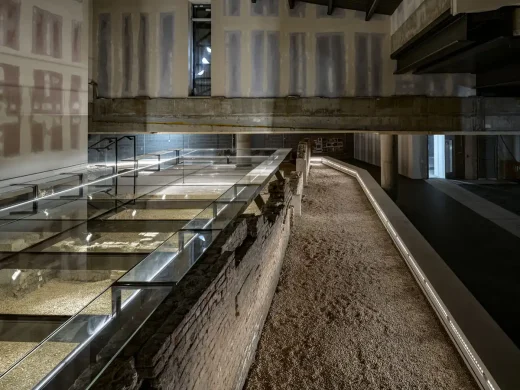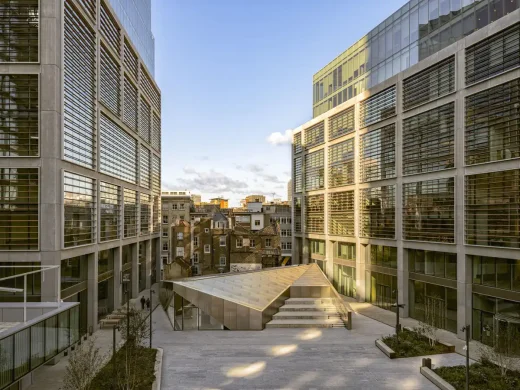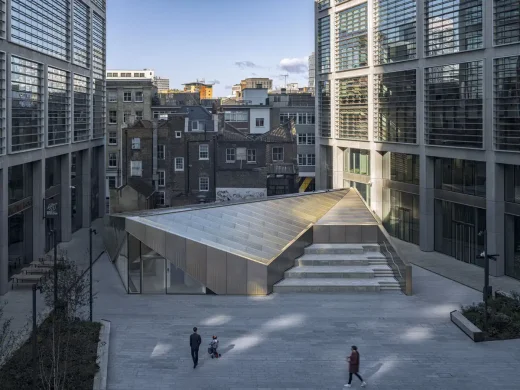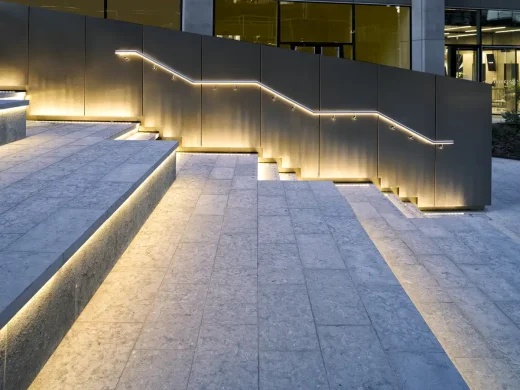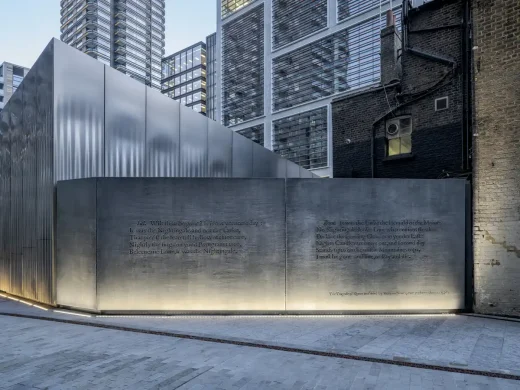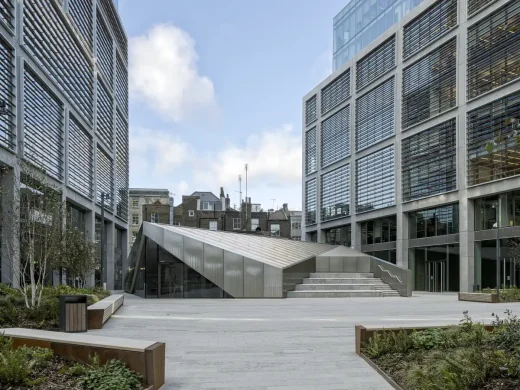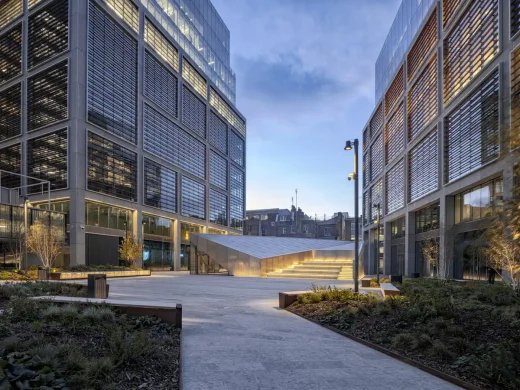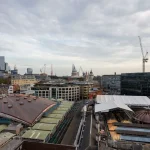Museum of Shakespeare London Shoreditch building photos, Curtain Playhouse England
Museum of Shakespeare London Shoreditch
17 October 2024
Location: Shoreditch, northeast London, southeast England, UK
The Stage is Set: Perkins&Will Completes Museum of Shakespeare at Heart of East London Urban Quarter
Design: Perkins&Will Architects
Photos © Timothy Soar
Museum of Shakespeare London Shoreditch News
New museum in Shoreditch, east London building designed by architect Perkins&Will, which will showcase the archaeological remains of Shakespeare’s Curtain Playhouse, where Romeo & Juliet and Henry V are believed to have been first staged.
+++
LONDON—Perkins&Will has completed the building work for a new destination museum in London, showcasing the archaeological remains of Shakespeare’s Curtain Playhouse, where the plays Romeo & Juliet and Henry V are believed to have been first staged. The Museum of Shakespeare forms the centrepiece of The Stage, a new mixed-use urban quarter in Shoreditch. The archaeological site that The Museum of Shakespeare will house was uncovered during early stages of construction. This prompted revisions to the masterplan to reveal and celebrate the historically significant remains.
The scheme, designed by Perkins&Will and developed by Cain International with joint venture partners McCourt, Galliard Homes, Vanke, and Investec, opens-up a previously impermeable site with new pedestrian routes and provides over an acre of public realm for the local community, including a landscaped public plaza, an amphitheatre, and a pocket park and play area above a restored Victorian railway viaduct.
The development also provides over 221,000 sq ft of contemporary workspace across two office buildings, as well as 412 homes, 39,000 sq ft of shops, restaurants and bars.
Sunand Prasad, Principal, Perkins&Will, said:
“The Stage project is a great example of the intelligent evolution of an urban quarter to create accessible, permeable and attractive space for people’s use and enjoyment. Built layers from several centuries, now repurposed, have been woven together with substantial new flexible mixed-use space gathered round a public plaza, to create the largest public space ever in Shoreditch. The discovered remains of the 16th Century Curtain Theatre that was London’s first Shakespearean playhouse, displayed in a new building that itself creates an amphitheatre, brings a magical extra dimension to the making of this new place for the busy neighbourhood.”
A new international museum
The Curtain Playhouse is first recorded as having opened its doors in 1577 and was a cultural and social centre for London during Shakespeare’s life. The theatre was the main venue for Shakespeare’s plays before The Globe opened at the end of the 16th century and historians believe Romeo & Juliet and Henry V were originally staged there. The theatre is thought to have continued staging plays until 1624.
The Museum of Shakespeare will conserve and showcase the remains of the playhouse, one of only two scheduled ancient monuments in the London Borough of Hackney, providing an international destination at the heart of the development, and making a valuable contribution to the cultural, social and economic development of the surrounding area. The designs for the Museum were refined in response to the emerging footprint of the archaeological remains of the theatre. This was initially thought to be round-shaped, like The Globe, but was discovered to be a rectangular building with a long stage, the earliest known example in London.
Moojan Kalbasi, Project Director, Cultural & Civic lead, Perkins&Will, said: “This project holds a special place in my heart as it represents a significant urban ensemble centered around a cultural space, combining my passion for urban design with cultural places. It also marked the beginning of my career many years ago at Perkins&Will. The remains of Shakespeare’s theatre have always been central to our design vision, and over the years, we have carefully crafted the project around the public plaza and the museum. We are extremely proud that the museum building has now reached completion, bringing a perfect conclusion to the scheme. I eagerly await seeing the space fitted out and filled with visitors.”
To both conserve and showcase the archaeology, Perkins&Will overcame numerous technical challenges, delivering an expansive museum building below ground level, that will allow visitors to walk over a floating glass viewing platform above the archaeological remains at the height of the original stage.
Above ground, the museum’s gently flowing roof blends in with the landscaped public plaza and the rest of the surrounding buildings, while optimising the viewing experience below ground, inside the building. The tiered seating incorporated into the structure provides an outdoor amphitheatre for the adjacent public plaza. Both the plaza and amphitheatre were designed to recreate and rekindling the buzz that once surrounded this site.
The stainless-steel façade provides a visual reference to a stage curtain with ripples. A bird-shaped cut out on the north façade allows the public to gaze down into the museum and archaeology. The cut-out references a ceramic bird whistle found during the excavation, which is thought to have been used for sound effects during the performance of the plays at the theatre, possibly for Romeo & Juliet. As a nod to the significance of this find, a quote from Romeo & Juliet referencing a bird is beautifully etched onto the museum entrance wall, using original fonts scanned from Shakespeare’s First Folio.
With the completion of the building, the museum experience will be delivered by leading creative studio Bompas & Parr, in collaboration with Cain International, Museum of London Archaeology and Historic England. The Museum will immerse visitors in a fantastical retelling of a day in the life of William Shakespeare in 1598, culminating in an opportunity to perform on the stage atop the archaeology.
A mixed-use development in Shoredtich – The Stage
Over a 13-year development programme, The Stage transformed a largely overlooked site less than five minutes from the busy Liverpool Street Station that previously comprised a mix of low-quality office and industrial buildings and some derelict structures, interspersed with valuable historic buildings.
Perkins&Will’s masterplan worked with the historic grain of the area to sensitively stitch a new mixed-use neighbourhood into the existing urban fabric through high quality design and considered placemaking. The site now provides new routes for pedestrians, while offering over an acre of thriving public realm in a dense urban area where there is a shortage of high-quality public space.
Ben Tooley, Managing Director, Cain International, said: “In collaboration with our partners we are proud to showcase the significant archaeological discoveries of the Curtain Theatre to the public within the thoughtfully designed surroundings of the Museum of Shakespeare. Once open, we anticipate the historic cultural centre will enjoy a new lease of life through a dynamic and immersive museum experience at the centre of the exceptional destination we are creating at The Stage.”
As well as designing the masterplan, Perkins&Will also delivered the detailed designs for the six new buildings across the scheme, including the two new office buildings, The Bard and The Hewett, and the residential building centred on the public plaza.
The development includes the restoration of a Victorian railway viaduct that once carried the North London Railway to Broad Street Station, which closed in the 1980s and is now the site of the Broadgate development. A pocket park with play areas, landscaping and a café has been delivered on top of the viaduct, while the historic railway arches have been sensitively restored to provide retail spaces beneath. Space for a restaurant and bar is also provided in a 10,756 sq ft sq ft building, called The Pavilion.
A Victorian attachment to the railway viaduct at 2a Fairchild Place, known as Peter the Pleater, has also been sensitively restored to provide retail space. The building was previously used for workshops, warehouse and retail spaces, with the name coming from a former curtain and fabric blind store at the location.
Adam Yang, Project Manager, Perkins&Will, said: “We worked closely with Cain International and navigated a complex planning process to deliver this scheme. Working with the area’s historic grain, we sensitively stitched a balanced mixed-use neighbourhood into the existing urban fabric, despite the complexity of developing such a constrained urban site in an historic area of central London. It has been a huge privilege to design the Museum of Shakespeare, which will now showcase the remains of the Curtain Playhouse long into the future. Our designs for the building needed to both overcome a range of technical challenges, while creating a space that complements its surroundings and will attract and inspire visitors to this important historical site for generations to come.”
The Stage park and play area above rail viaduct:
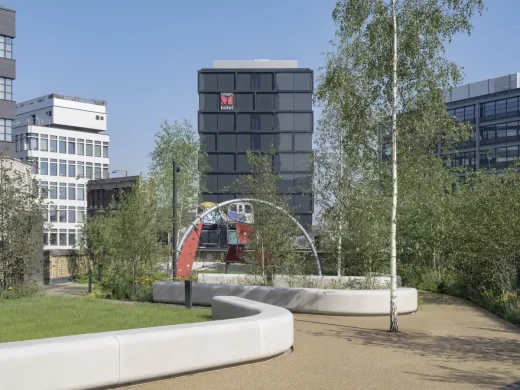
###
Curtain Playhouse London
BACKGROUND TO THE CURTAIN PLAYHOUSE
• London’s Curtain Playhouse was a cultural and social centre for the city during the life of Shakespeare. The theatre is first recorded as having opened its doors in 1577. It was located in Shoreditch, east London, an area that can lay claim to being the birthplace of modern theatre.
• Audiences flocked to the Curtain Playhouse to enjoy theatrical performances and other forms of entertainment, including clowning, bowling, jigging and fencing, with a small break in the late 16th century as the plague gripped the capital. Historians believe the theatre continued staging plays until 1624.
• William Shakespeare’s acting troupe, The Lord Chamberlain’s Men, used the Curtain Playhouse as their base from 1597-1599. In that time, it is believed that Henry V and Romeo & Juliet debuted at the Curtain and that other famous plays were performed there, including Every Man in His Humour, which starred Shakespeare himself. It was the main venue for Shakespeare’s plays until the Globe was officially completed in Southwark at the end of the 16th century.
• The Curtain Playhouse is one of the earliest purpose-built theatres in London, and is referenced as Shakespeare’s original “wooden O” in the famous prologue to Henry V which was first performed at the Curtain: “Can this Cock-Pit hold within this Wooden O, the very Caskes that did affright the Ayre at Agincourt?”
• Historical records always pointed to the Curtain Playhouse being close to modern-day Curtain Road in Shoreditch, east London. In 2011, archaeologists from the Museum of London Archaeology (MOLA) were undertaking exploratory excavation for The Stage development when they came across the remains of the Curtain Playhouse.
• This trial excavation only revealed a very small section of the Tudor building, which they initially anticipated would be oval-shaped, like the Globe, but an open-area excavation, which took place in spring 2016, allowed archaeologists to expose all of the surviving remains, with the theatre revealed to be a rectangular building with a long narrow stage, the earliest known example in London.
• All of the numerous artefacts uncovered were taken back to MOLA and examined by experts and the archaeological and historical material brought together. These will be showcased in the Museum of Shakespeare.
• The Museum will explain the significance of the site and display artefacts including a ceramic bird whistle, thought to have been used for sound effects, pottery money boxes—which had to be smashed to extricate the day’s box office receipts—as well as dropped buttons, clay pipes, pins, coins and nutshells from theatre snacks. Visitors will look down on the foundations of the stage through a glass floor and the gravelled yard where rowdy groundlings paid sixpence to stand.
Museum of Shakespeare in Shoreditch
• The museum experience will be delivered by leading creative studio Bompas & Parr, in collaboration with Cain International, Museum of London Archaeology and Historic England and is scheduled to open in 2025.
• The Museum of Shakespeare will be a new immersive and interactive permanent experience transporting guests to the 16th Century to walk in the footsteps of the famous playwright. The Museum will immerse visitors in a fantastical retelling of a day in the life of William Shakespeare in 1598, culminating in an opportunity to perform on the stage atop the archaeology.
• Set within the archaeological remains of The Curtain Playhouse, one of only two scheduled ancient monuments in Hackney, visitors will be able to immerse themselves in the culture of Elizabethan London to learn about the life, inspirations, and creative process of William Shakespeare.
• The museum experience will include original objects from the time alongside multisensory experiences and a chance to walk on the stage where Shakespeare presented plays such as Romeo & Juliet and Henry V.
• Hosting a variety of activities from plays to fencing matches, The Curtain Playhouse was a cultural and social centre for the city during the life of Shakespeare. An archaeological excavation of the site during 2011-16 revealed its remains, with the Museum of Shakespeare now making them publicly accessible for the first time enabling scholars and the public alike to learn more about this important site and its fascinating history.
• Located three metres underground and four centuries back in time, guests will be immersed in a fantastical retelling of a day in the life of William Shakespeare, presented through dynamic experiences, innovative theatrical technology and archaeological discoveries.
• Set in the year 1598, a time of great creative risk and opportunity for a young Shakespeare, visitors to the Museum of Shakespeare will soak up the sights, smells, sounds and people that inspired his plays, as well as have the chance to take centre stage and demonstrate their own flare for performance and creative storytelling.
• Standing above the remains of the stage, visitors will be surrounded by a projected reconstruction of the Playhouse, presenting a unique opportunity to stand in the heart of the theatre experience, whilst AI technology will place guests in animated performances and scheduled workshops will bring audience creativity to life.
Museum of Shakespeare London Shoreditch – Building Information
• Location: The Stage, Shoreditch, London EC2A 3NL
• Local authority: London Borough of Hackney
• Type of project: Mixed-use – office, retail, leisure, residential, cultural, public realm
• Client: Cain International with joint venture partners McCourt, Galliard Homes, Vanke, and Investec
• Master planner: Perkins&Will
• Architect: Perkins&Will
• Landscape architect: Townshend Landscape Architects
• Planning consultant: Montagu Evans
• Structural engineer: Walsh (Glass Stage viewing platform in Museum building by Eckersley O’Callaghan)
• M&E consultant: HDR
• Quantity surveyor: Gardiner & Theobald
• Main contractor: CJ O’Shea
• Start on site: 2017
• Completion: September 2024
• Gross internal floor area (sq ft)
o The Hewett (office, B2): 80,793
o The Bard (office, B3): 144,290
o The Pavilion Restaurant (B5): 7,632
o The Pavilion Bar (B4): 3,124
o Residential (B1): 450,055
o Viaduct (B6): 9,128
o Museum (B7): 15,166
Perkins&Will
Perkins&Will, an interdisciplinary, research-based architecture and design firm, was founded in 1935 on the belief that design has the power to transform lives. The firm is committed to creating a better, beautiful, more equitable world through Living Design, an approach that integrates environmental, social, and design considerations to advance ecological health and well-being.
Architizer named Perkins&Will the world’s “Best Sustainable Firm” in 2023, and Metropolis named it “Firm of the Year” in 2022 for its industry leadership in advancing climate action and social justice. Fast Company named Perkins&Will one of the World’s Most Innovative Companies in Architecture three times, and in 2021, it added the firm to its list of Brands That Matter—making Perkins&Will the first architecture practice in the world to earn the distinction.
With an international team of more than 2,400 professionals, Perkins&Will has 33 studios worldwide, providing integrated services in architecture, interior design, branded environments, urban design, and landscape architecture. Partners include Schmidt Hammer Lassen Architects; Portland; Nelson\Nygaard; and Pierre-Yves Rochon (PYR). For more information, visit www.perkinswill.com.
Cain International
Cain International (‘Cain’) is a privately held investment firm focused on real estate and business opportunities that shape the fabric of global gateway cities. The firm currently manages over $16 billion in assets through its real estate equity, real estate debt and private equity platforms. Cain is a partnership between its CEO, Jonathan Goldstein and Eldridge. Cain International Advisers Limited, the firm’s asset management and investment advisory division, is an SEC-registered investment adviser. For additional information about Cain please visit www.cainint.com.
Photos © Timothy Soar
Museum of Shakespeare London Shoreditch building – Curtain Playhouse images / information received 171024
Location: Shoreditch, London, England, United Kingdom
New Shoreditch Building Designs
New Shoreditch Architecture Designs – recent architectural selection from e-architect below:
Virgin Hotels London-Shoreditch, 45 Curtain Road, northeast London
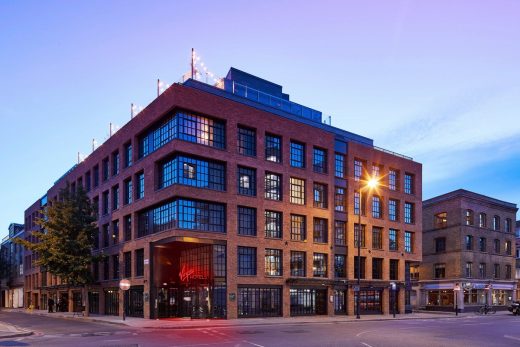
photo courtesy of architects practice
Virgin Hotels London-Shoreditch building
London Buildings
Contemporary London Architecture Designs
London Architecture Designs – chronological list
London Architectural Tours – tailored UK capital city walks by e-architect
Design: Norman Foster – Foster + Partners
Canary Wharf Station
Spire London Docklands Tower
Design: HOK, Architects
Spire London Docklands Tower
Perkins and Will Architects News
Comments / photos for the Museum of Shakespeare London Shoreditch building photos, Curtain Playhouse England building design by architects page welcome.

